Nosferatu taps into our current need for the strongman: someone to fuck us, tell us what to do, and fuck over whoever gets in the way. It aims to make its villain a repulsive corpse while maintaining his seductive powers and even his sex appeal. The film reflects how media covers vulgar sociopaths in politics and business and the blatant, odd homoeroticism of the MAGA movement—like Mel Gibson swooning on Fox about how "Daddy arrived, and he's taking his belt off," with a straight face. While Gay media is direct about its daddy issues (Tom of Finland’s images, S&M role-play), hetero media tends to coat theirs in hero-monster stories. Female sexuality, meanwhile, was depicted in the film much as it was by the Victorians and modern conservatives: an unmanageable force shrouded in mystique.
I found myself wishing for a tiny bit of levity to break the tension. It’s an exercise in dread, but some of the scenes bordered on camp. It’s gorgeous but relentlessly bleak, made for an audience numbed by equally dreadful and disparate social media feeds. Its finale was a perfect “viral” moment, as beautiful as it was disgusting.
Nosferatu's era is another Gilded Age of industrialization, new technology, dubious science, plagues, and wealth inequality. Though it was set in the 1800s, it felt very much of our time.
Actual Daddy stories and more media reviews in Analog Cruising and POST.
Keep reading with a 7-day free trial
Subscribe to Herrera Words to keep reading this post and get 7 days of free access to the full post archives.






